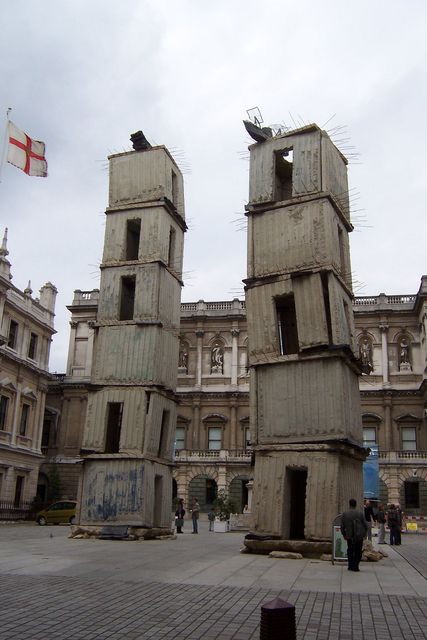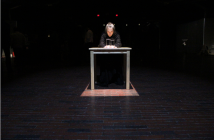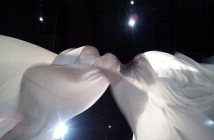My Sunday morning New York Times-and-coffee ritual was sullied by another piece of lazy art-collector-bashing proclaiming that "Wall Street high rollers and Chinese, Russian and Latin American tycoons" buy art only as a place to "park their money" and therefore the art they buy is overvalued and not "quality." How is it that I keep finding myself in the strange position of acting as defense in the case of ‘outraged art critic v. blue-chip art investor.’ My own background is closer to "trailer trash" than "blue-chip art investor." (Lived in a trailer? Check. Raised by a single mother on food stamps and welfare? Yep.) And it’s not that I don’t understand how the high price of art can make people squeamish. I will never forget the moment of my personal epiphany on this subject.
On that particular day, I was was on a high floor of Trump Tower in the apartment of a British ex-pat of the Sloane Ranger variety who collected 20th Century German paintings with her investment-banker husband. The living room had floor-to-ceiling windows with a view of the Statue of Liberty. I joked with Mrs. Collector that the view was giving me vertigo to which she replied quite seriously that her toddler son, playing quietly near us with his Filipina nanny, was terrified of the windows which sometimes made popping and creaking sounds when the weather changed.
I was there that afternoon on behalf of Christie’s to advise Mrs. Collector on the valuation of a large Anselm Kiefer which had been damaged by a leaky Jacuzzi on the floor above. When I said the estimated fair-market value out loud—lower as a result of the conservation but still a boatload of money—Mrs. Collector hissed "Mind the help!" in my ear. At that moment the ethical question of valuing a Jacuzzi-damaged painting at far more than the value of a year in the life of the Filipina nanny behind us (and indeed more than my own salary, hardly enough to keep me in the unofficial uniform of a Christie’s girl who must always look as if she can afford to buy the work she is selling) became uncomfortably real. I left Christie’s soon after. It took me a long time to regain the ability to see art without seeing Matrix-like green flashing dollar signs and I still get a chill when I think of Mrs. Collector, her son and the nanny.
But my epiphany was about capitalism and human worth. I have never doubted the moral value of making, buying, selling or owning art. Kyle Chayka, writing on January 2nd in Hyperallergic, contextualizes the $64 billion dollar art market within the framework of other markets but the commodities he chooses for comparison are alcohol, tobacco, and arms. Is Chayka suggesting that buying art is a vice akin to smoking, drinking and murder?
What Chayka, Cole, and all the letter-writers in today’s Op-Ed section share is not a skepticism about capitalism, but rather a tone that suggests a skepticism about the moral value of art. Cole does not suggest that this money would be better spent on improving public education in the US or providing clean water in the Third World, No, he is upset that these "blue chip investments" are "outright junk."
I wonder sometimes if the art community’s mistrust of blue-chip artists and those who collect them has something to do with insecurity about the moral "value" of art or an Old Testament bias involving rich men, camels and the eye of a needle? Are we mistrustful of people who pay a lot for art because deep down we think that collecting art is more like smoking and drinking than philanthropy?
Sometimes I think that artists are more like Lindsay Lohan’s Mean Girls than a group of supportive professionals: if an artist has a "day-job" then their art is an avocation; if an artist is able to support themselves modestly that’s okay; but if they are too successful then they risk being viewed as sluts. The hagiography of artists who practiced lifestyles of self-abnegation (Agnes Martin, David Smith, Van Gogh, Bacon, etc.) are often held in positive contrast to the luxe lifestyles of high-rollers like Hirst and Koons. The Wikipedia page for "asceticism" even lists "starving artist" as an example of "secular asceticism."
If you will permit me a Carrie Bradshaw moment, I want to share a few questions with you. If you have any answers I would love to hear from you.
Do we think that being a "real" artist should be more of a vocation or a spiritual calling?
Should we artists/art dealers/art critics/art historians ever feel guilty that we aren’t doing something more "useful"?
Does a lifestyle of self-imposed poverty or asceticism make a "better" artist?
Is it morally defensible for a collector to to spend millions on art?
Do we critique the work of artists who sell for a lot of money differently than those who don’t?
- Anselm Kiefer’s Jericho at the Royal Academy of Art, London





